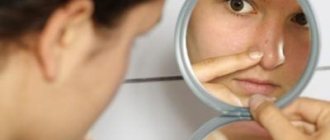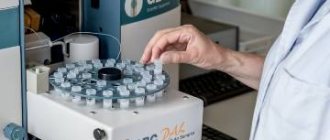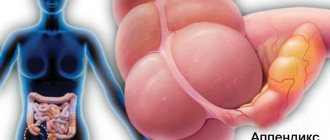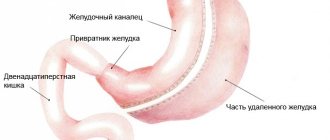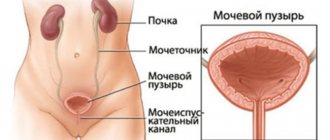A natural decrease in estrogen levels in the female body occurs during menopause. Lack of estrogen in postmenopausal women is manifested by the development of osteoporosis, atherosclerotic vascular lesions, decreased skin elasticity, deterioration of the structure of hair and nails, dryness and atrophy of the vaginal mucosa, the appearance of “hot flashes,” disturbances in the emotional background (the appearance of irritability, moodiness, tearfulness), etc. d.
Most women believe that estrogen deficiency can only occur during menopause. However, this is not quite true. Symptoms of estrogen deficiency in women can occur at any age and have a variety of causes.
In the absence of timely normalization of hormonal levels, low estrogen levels can lead to menstrual irregularities, decreased sexual desire, early appearance of wrinkles, infertility, virilization (deepening of the voice, male pattern hair growth, reduction of mammary glands), etc.
Reasons for decreased estrogen levels
One of the common reasons for the development of estrogen deficiency in women is emotional overstrain (stress), sleep deficiency, depressive disorders (while the lack of estrogen provokes a further worsening of depression), excessive physical activity or physical inactivity (lack of physical activity), and dieting.
Also, low estrogen levels can be observed after severe injuries, infectious pathologies, exhaustion, against the background of vitamin deficiencies, and during the acclimatization period after a change of place of residence.
In such cases, normalization of estrogen deficiency occurs after restoration of normal sleep and rest patterns, good nutrition, and physical activity. If necessary, multivitamin preparations and herbal remedies are prescribed to increase estrogen levels.
However, it should be understood that a lack of estrogen can also be observed in serious diseases that require complex treatment, therefore, if symptoms of hormonal imbalance appear, you should consult a gynecologist-endocrinologist.
Self-prescribing medications to increase estrogen in women or treating with traditional medicine is strictly prohibited.
Symptoms of estrogen deficiency in women can also be observed due to:
- diseases of the hypothalamic-pituitary system;
- disturbances of hormonal function of the ovaries;
- benign or malignant ovarian lesions;
- polycystic ovary syndrome;
- hyperandrogenic conditions;
- adrenogenital syndrome;
- genetic disorders accompanied by low estrogen levels in women;
- postpartum hormonal imbalance;
- carrying out radiation therapy or chemotherapy.
https://youtu.be/AdmY5lCPt4g
Reducing the concentration of male hormones in a woman’s body
If a woman experiences baldness and at the same time her body hair begins to grow rapidly, fat deposits in the waist area increase, and acne appears, all this may indicate an excess of male hormones in her body. In this case, you need to consult a doctor who will prescribe appropriate treatment.
You can reduce testosterone levels by resorting to the following means:
- Oral contraceptives. Your doctor will tell you which ones to take during treatment.
- Dietary supplements should also be recommended by a doctor.
- Limit intake of foods containing magnesium and zinc. These minerals help increase testosterone levels.
- Enrich your diet with foods containing estrogens. Eat dishes made from rice, wheat cereals, soy products more often; among fruits, give preference to apples and cherries.
- Lead an active lifestyle, giving priority to yoga and Pilates.
- In difficult cases, the doctor will prescribe a course of hormonal therapy.
Normal estrogen levels in women
The level of estrogen (estradiol) in women depends on age and the phase of the menstrual cycle. Indicators are measured in pmol/l.
- In girls of the first year of life, estrogen levels are less than one hundred and fifty-five pmol/l.
- In patients from one to five years old - up to ninety-eight pmol/l.
- From five to ten years - up to one hundred thirty-eight;
- From ten to fourteen years – less than 355 pmol/l.
- And from fourteen to eighteen years – less than 953 pmol/l.
- In women over eighteen years of age, estrogen levels are largely determined by the phase of the menstrual cycle.
- In the follicular phase, estrogen levels range from sixty-eight to 1269 pmol/l.
- In ovulatory – from one hundred thirty-one to 1655.
- Luteal phase – from ninety-one to eight hundred and sixty-one pmol/l.
- During menopause, estrogen levels are less than seventy-three.
Symptoms of a lack of female hormones estrogen
Symptoms of female sex hormone deficiency depend on the patient’s age and the severity of hormonal disorders.
In girls, a lack of estrogen is manifested by the absence of menstruation, impaired development of secondary sexual characteristics (the mammary glands do not develop, there is no pubic hair). It is also possible that male pattern hair growth, deepening of the voice, and the development of severe forms of acne may occur.
An ultrasound examination of the pelvic organs may reveal a small, age-inappropriate size of the uterus and ovaries.
In adult women, a lack of estrogen is manifested by a decrease in sexual desire, the appearance of constant dryness in the vagina, pain during sexual intercourse, weakness of the pelvic muscles, prolapse of the uterus, the appearance of papillomas, decreased skin elasticity, early appearance of wrinkles, menstrual irregularities, impaired thermoregulation, and the appearance of excessive emotional lability and frequent mood swings, anxiety, the appearance of hot flashes, hair loss, and the development of severe acne.
Against the background of constant vaginal dryness and disruption of its normal microflora, frequent development of thrush, vaginitis, etc. is noted.
There is also a decrease in bone strength, and signs of early osteoporosis appear.
It should be noted that estrogens play an important role in maintaining vascular elasticity, reducing cholesterol levels, preventing the development of atherosclerotic vascular lesions and the development of cardiovascular pathologies.
With estrogen deficiency, combined with an increase in the amount of androgens, signs of virilization are observed. The voice becomes rough, the mammary glands atrophy, coarse hair begins to grow on the face, stomach and chest, etc.
Symptoms of estrogen deficiency during menopause may include:
- the appearance of migraine attacks, constant headaches, profuse sweating, severe fatigue,
- increased irritability,
- urinary incontinence (due to weakness of the pelvic floor muscles),
- constant dry skin,
- brittleness and dryness of hair,
- bloating,
- the appearance of dandruff,
- heart rhythm disturbances,
- pronounced disturbances in thermoregulation,
- feeling of heat (hot flashes), alternating with chills,
- unstable blood pressure (with a tendency to increase it), etc.
Lack of estrogen: manifestations
Estrogen is a purely female hormone. In all senses. He begins his “wife-forming” work in childhood during puberty. It is thanks to estrogen that in girls everything that should be rounded is rounded, the voice becomes soft and gentle, childish bouncyness and spontaneity are replaced by femininity and gentleness of character. And most importantly, the ability to bear children appears.
If this hormone is not enough, various symptoms appear:
- Weakness, lethargy, fatigue, decreased performance, forgetfulness, absent-mindedness, decreased sexual desire.
- Mood swings. Women's emotionality in general directly depends on hormonal levels. Just a minute ago the lady was smiling sweetly, but she has already clenched her fists and sprayed saliva. Have you encountered a bitch and a hysterical woman? Are you becoming like this yourself? If it’s just a one-time thing, no matter what, it’s impossible to be nice forever. And if it constantly “covers” like this, up to , then the hormonal balance is disturbed, this is 99%.
By the way, there is an interdependent relationship here. Sometimes psychosomatics are to blame for the lack of estrogen
- External changes. Insufficient estrogen synthesis affects the figure: the breasts sag, and they are deposited more quickly on the waist. The skin loses elasticity, becomes dry, and wrinkles appear early. Hair becomes dull and thin.
- Lack of calcium. Estrogen is involved in the normal absorption of calcium by bones. If it is not enough, caries develops, and posture is disturbed.
- Menstrual irregularities. This manifests itself from irregularity and painful periods to their complete absence for even six months. Hence the inability to get pregnant, infertility.
- Early menopause. Even in young women, decreased hormones resemble the symptoms of deficiency during menopause: surges in blood pressure, hot flashes, night sweats, palpitations, etc.
- Disorders in the genitourinary area: infections, cystitis, vaginal dryness, pain during sexual intercourse, diseases of the uterus: fibroids, endometriosis, endometritis - the temperature in the rectum (basal) increases.
- and an abundance of moles - also here.
How to Increase Estrogen Levels in Women
It is necessary to understand that self-medication can be dangerous to health, so a doctor should prescribe measures to increase estrogen levels. Independent choice of drugs is unacceptable.
With a slight hormonal imbalance not associated with cysts or malignant neoplasms of the ovaries. Also damage to the hypothalamic-pituitary system, etc. Diet and normalization of lifestyle may be prescribed.
It is necessary to consume a sufficient amount of protein foods (boiled meat, dairy products). And also increase your consumption of fresh herbs, fruits and vegetables. It is good to reduce the consumption of flour, sweets, soda and alcohol.
It is also recommended to quit smoking.
Foods that increase estrogen include legumes, cabbage, apples, figs, pomegranates, etc.
It is effective to use flaxseed, soybean or sesame oil, decoctions of oregano, linden, sage, and mint.
Not enough female hormones: what to do and how to prevent it?
- monitor your health and pay attention to all changes;
- start eating healthy and varied, include more fruits and vegetables, fish and meat in your diet;
- maintain a drinking regime - try to drink as much liquid as possible, including natural juices;
- try to be less nervous and avoid stressful situations;
- find a hobby;
- give up bad habits - coffee, smoking, alcohol;
- try to establish a daily routine - fall asleep and wake up at the same time, be sure to sleep at night - only at night can our body fully rest and recuperate;
- Be careful when choosing oral contraceptives - before taking anything, consult a specialist.
In order to improve your hormonal balance, find a hobby and be less nervous.
Changes in hormonal levels can be influenced by a variety of factors: weather conditions, stressful situations, diets, various medications, age-related changes in the body and much more.
Causes of estrogen deficiency in the body
Estrogen levels fluctuate naturally depending on the current state of the body (phase of the menstrual cycle, pregnancy) and normally decrease significantly only during menopause (45–50 years). At other times, a sharp drop in hormone levels indicates health problems.
Estrogen deficiency (hypoestrogenism) - in most cases occurs due to inhibition (extinction) of the functions of the ovaries, which produce most of the sex hormones.
As well as pathological disorders in the functioning of the adrenal cortex, thyroid gland or pituitary gland, which develop under the influence of negative factors:
- grueling strength loads, including professional sports training;
- lack of physical activity (physical inactivity);
- abuse of alcoholic beverages, cigarettes and drugs;
- strict diet with low fat and iron intake, unbalanced diet;
- sudden jumps in body weight in any direction;
- improper use (self-prescription) of hormonal drugs;
- long-term treatment with gonadotropin-releasing hormone (GnRH) antagonists, antidepressants or nootropics;
- bad heredity;
- irregular sexual relations;
- malignant process of tumor development;
- course of radiation or chemotherapy of the pelvic organs;
- surgical removal of the uterus with appendages, resection of the ovaries;
- prolonged depressed psycho-emotional state, nervous tension, depression.
Lack of hormones in women: what tests to take?
At the first signs of malfunctions in the body, excess weight, excessive emotionality, a tendency to depression and other symptoms, a woman should urgently consult a doctor. After the examination, he will identify problem areas and refer the patient for tests.
Depending on the nature of the problem and symptoms, the specialist may prescribe tests for the level of sex hormones, the thyroid gland or the pituitary gland.
What hormone tests are prescribed for pregnant women?
During pregnancy, a lack of hormones in women can lead to particularly serious consequences. The list will differ depending on the patient’s health status, diseases, age, and symptoms.
During pregnancy, women experience a hormonal surge.
The tests common to all are as follows:
- human chorionic gonadotropin (hCG), estriol and AFP - allows timely detection of abnormalities in the development of pregnancy;
- estradiol - responsible for normal gestation;
- progesterone - a lack of female hormone will indicate a threat of miscarriage;
- prolactin - will show whether the pregnancy is post-term;
- SHBG allows you to predict the likelihood of complications during childbirth.
Low level symptoms
In women of reproductive age (16–48 years), estrogen deficiency is manifested by both specific and general signs of illness:
- loss of skin elasticity and firmness (turgor), uneven microrelief, formation of deep wrinkles, dehydration and peeling;
- the appearance of acne, age spots, moles and papillomas in large quantities (up to 20 pieces in 1 year);
- deterioration of the figure, sagging breasts (mastoptosis), the formation of stretch marks (striae) and congestion in the subcutaneous adipose tissue, i.e. cellulite (lipodystrophy);
- redistribution of body volumes (massive top, narrow bottom, large belly) and male-type hair growth;
- uncontrolled hair loss, dullness of color, fragility, dryness and split ends;
- disruptions of the menstrual cycle, i.e. irregular periods (once every 2–4 months) or their complete absence (amenorrhea), changes in the quantity and quality of discharge, severe premenstrual syndrome (PMS);
- frequent diseases of the genitourinary system of an inflammatory nature (colpitis, cystitis, vaginitis);
- atypical discomfort during intimacy and urination, vaginal dryness (atrophic vaginitis), incontinence, impaired mobility (contracture) of the genital muscles;
- decreased performance and self-confidence (self-esteem), loss of a positive moral attitude, lack of sexual desire, insomnia, irritability and unreasonable aggressiveness;
- sudden changes in blood pressure, excessive gas formation (flatulence), pain in the heart and joints, increased heart rate, increased temperature and increased sweating (hot flashes);
- tooth decay, increased fragility of bones (osteoporosis) and nails.
In childhood and during puberty, a lack of estrogen is no less dangerous than in adulthood, so it is very important to detect it in a timely manner.
Characteristic signs of hormonal imbalance in adolescence:
- delayed sexual development (absence of menstrual flow, unexpressed mammary glands, small size of the uterus);
- frequent fractures, skeletal deformation, tooth decay;
- a large amount of hair on the face and body (if this is not related to nationality or heredity);
- shaping a male-type figure, stretch marks on the skin, unreasonable weight gain.
Low estrogen levels after menopause are a natural phenomenon that is considered normal. However, often during this period a woman suffers from a deterioration in her health, so at this age the symptoms of hypoestrogenism also need to be corrected with the help of special therapy.
What about excess?
This is how we are designed, that there should be balance in everything. And excess is just as harmful as deficiency.
The signs of excess are essentially the same as those of deficiency. There is something of its own:
- . This is the main sign. Moreover, all the fat accumulates in the lower part: legs, hips, buttocks, lower abdomen;
- Frequent hunger;
- Increased emotionality;
- Increased blood clotting;
- Pain not associated with menstruation;
- Convulsions;
- Thyroid diseases;
- Indigestion, bloating;
During menopause and postmenopause, excess appears very rarely, mostly there is an acute deficiency.
Diagnosis of shortage conditions
The norm changes throughout life: it depends on age, the phase of the menstrual cycle and the duration of pregnancy.
To determine the overall level of the hormone, as a rule, the level of estradiol in the blood is used, since in terms of the ratio of biological activity it is significantly superior to other steroids (E1-6 : E2-100 : E3-1).
Norms
Reference values for estrogen content in the body:
| Life stage of development of the female body | Estradiol level | |
| ng/l | pmol/l | |
| Childhood before puberty (up to 12–14 years) | 5–22 | 18,4–80,8 |
| Reproductive age (15–50 years) | ||
| — follicular phase of the cycle (7–13 days) | 23–139 | 84,4–510,3 |
| — ovulatory phase of the cycle (14–15 days) | 83–495 | 304,7–1817,1 |
| — luteal phase of the cycle (days 16–28) | 42 –338 | 154,2–1240,8 |
| Gestational age | ||
| — I trimester (1–13 weeks) | 203–3980 | 745,2–14610 |
| — II trimester (14–26 weeks) | 1005–17880 | 3689,4–65674 |
| — III trimester (27–40 weeks) | 4353–17600 | 15979–84609 |
| Postmenopausal period (after 50–55 years) | 5–48 | 18,4–176,2 |
A deficiency of female hormones is diagnosed through a venous blood test, so before collecting material you must adhere to the standard recommendations for this type of research:
- 1–1.5 weeks in advance - stop taking all medications (if this is not possible, give the doctor a specific list of medications in advance);
- 5–7 days in advance - avoid sexual arousal and sexual intercourse;
- 3-4 days in advance - exclude fatty, spicy foods and alcoholic drinks from the diet;
- 1–2 days in advance – limit intense physical activity (rest more, don’t play sports) and smoking;
- 10–12 hours in advance - stop eating any foods (drinking is allowed without restrictions).
It is advisable to come to the laboratory early in the morning (7–11 o’clock) 20–30 minutes before the appointed time, so that excessive stress, including emotional stress, does not distort the result obtained.
How to influence the normalization of hormonal levels?
The hormonal system reacts very sensitively to any changes in the body, so in order to stabilize estrogen levels, first of all, you need to normalize your lifestyle and health:
- maintain a proper daily routine (at least 8 hours of sleep at night, daily physical activity, proper rest);
- balance your diet in terms of the content of useful components (vitamins, micro- and macroelements) and nutritional value (KBZHU);
- eliminate bad habits (smoking, taking drugs) and minimize the consumption of alcoholic beverages;
- try to avoid stress and psycho-emotional tension, learn to restore mental balance (do auto-training, yoga, creativity, aromatherapy, etc.);
- have an active, regular sex life with a regular partner;
- promptly treat all disturbing ailments, prevent chronic diseases and do not take any medications without a doctor’s prescription.
Methods for treating the consequences of hypoestrogenism
In matters of conservative treatment of estrogen deficiency, official medicine adheres to the principle “less is more.”
Therefore, in the vast majority of clinical cases, it is not natural analogues of the hormone that are prescribed, but synthetic drugs in which the active component has a new, more active chemical structure.
Drugs prescribed for hormone replacement therapy (HRT) for absolute hypoestrogenism:
| Active substance | Release forms | Name of drugs |
| 17-β-estradiol (estradiol) | ointment for external use | Dermestril, Klimara, Menorest, Proginova, Estraderm, Estrimax, Estrogel, Logest, Yarina, Lindinet |
| solution for intramuscular administration | ||
| nasal drops | ||
| coated tablets | ||
| transdermal therapeutic device (subdermal implants) | ||
| estriol | vaginal cream | Ovestin, Ortho-ginest, Estrovagin, Estriol, Estrocad |
| suppositories (candles) | ||
| coated tablets | ||
| estrone | coated tablets | Femara, Estron |
| ethinylestradiol | coated tablets | Microfollin (forte), Ethinyl estradiol |
| conjugated estrogens (estrogens conjugate) | coated tablets | Premarin, Presomen, Hormoplex, Estrofeminal |
| polyestradiol phosphate | lyophilisate (in powder form) for the preparation of solution for intramuscular administration | Estradurine |
| estradiol valerate (oestradioli valeras) | coated tablets | Proginova, Klimonorm, Klimen Indivina, Divisek, Divina |
If the cause of the deficiency is an excessive level of progesterone, i.e. there is relative hypoestrogenism, then the doctor prescribes antiprogestins: Clomiphene, Tamoxifen, Mifepristone.
In addition to the main therapy that replenishes estrogen in women, you can pay attention to methods of alternative (traditional) medicine:
- 2 tbsp. l. raspberry leaves + 1 tbsp. l. field mint + 300 ml of boiling water – leave for 30–40 minutes and drink 150 ml 2 times a day, morning and evening;
- 1–1.5 tbsp. l. hop cones + 200 ml of boiling water – boil for 20–30 minutes over low heat and drink 50 ml 4 times a day after each meal;
- 2 tbsp. l. nettle leaves + 200 ml of boiling water – leave for 15–20 minutes and drink 100 ml 2 times a day before meals;
- 2 tbsp. l. sprouted ground broccoli seeds + 500 ml flaxseed oil - keep for 7-10 days in a cool, dark place and take 1-2 tbsp. l daily on an empty stomach;
- 1 tbsp. l. plantain seeds + 1 tbsp. l. mantle seeds + 300 ml of boiling water - boil for 10-15 minutes over low heat and drink 100 ml 3 times a day before meals.
The use of home methods for correcting estrogen levels also requires consultation with a specialist, since despite their apparent safety, they can significantly affect a woman’s hormonal levels.
Is it possible to get pregnant with low blood pressure?
Estrogen is essential for successful conception, pregnancy maintenance, and fetal development.
Its low content (less than 12–190 ng/l) can lead to the inability to get pregnant at all or to serious problems in the first trimester, both for the expectant mother and the child:
- threat of spontaneous abortion (fetal rejection);
- damage to the placenta, which in most cases ends with its detachment;
- “freezing” of embryo development or the presence of genetic abnormalities;
- pathologies in the functioning of the cardiovascular and nervous systems of the fetus;
- uterine bleeding.
Deficiency in later stages can cause post-term pregnancy and difficult delivery (weakness of labor).
Maintaining hormonal balance in the body is one of the main priorities in a woman’s life, because a lot depends on it: her beauty, well-being, sexual attractiveness and, most importantly, the opportunity to become a mother. Therefore, it is very important to monitor your health and consult a doctor in a timely manner.
Estrogens are the most important sex hormones in a woman’s body. They affect the organs of the reproductive system, affect the functioning of the nervous system and take part in many metabolic processes.
For a number of reasons, a deficiency of this hormone may occur in the female body. It leads to a deterioration in the woman’s well-being and the emergence of health problems. In this publication, we will take a closer look at the symptoms of lack of hubbub and how to increase estrogen levels in women.
The role of progesterone and the effect of its deficiency on the course of pregnancy
Progesterone is produced by the corpus luteum during ovulation. Progesterone is called the pregnancy hormone and not without reason, since it is responsible for the processes of regulating the menstrual cycle, conceiving and bearing a child. By relaxing the muscle tissue of the uterus during pregnancy, this hormone prevents its premature contraction. Lack of progesterone negatively affects the condition of the female body, especially during pregnancy.
Symptoms of progesterone deficiency during pregnancy:
- Miscarriages in the first trimester.
- Pathologies in the form of oligohydramnios or polyhydramnios.
- Bloody issues.
Progesterone deficiency. Causes:
- Intrauterine growth retardation.
- Exceeding the period of gestation.
- Exposure to stress.
- Lack of vitamins.
- Uterine bleeding.
- Self-medication and uncontrolled use of medications during pregnancy.
The first signs of low hormone levels
The female hormone estrogen affects many processes occurring in a woman’s body, therefore, its deficiency manifests itself in a variety of health and well-being disorders. Symptoms of estrogen deficiency may vary among females. However, there is a general trend.
The most common first symptoms of estrogen deficiency in women can be identified:
- fast fatiguability;
- causeless irritability;
- mood swings;
- increased sweating;
- sleep disorders, up to the appearance of insomnia;
- increase in body weight.
There is no doubt that a low level of estrogen is indicated only by an increase in a woman’s weight in the absence of reasons leading to this.
This means that the woman has not changed her diet and way of life - playing sports, doing physical labor, as well as time for walking and dancing. After all, if you spend all your free time watching your favorite TV series, eating kilograms of cakes and candies, then the reason for excess fat folds is not only low estrogen.
The importance of other hormones for women's health
It is difficult to overestimate the role of thyroid hormones produced by the thyroid gland. Their deficiency leads to problems with conception.
Treatment with drugs containing iodine will help solve this problem, but in any case, consultation with a specialist is necessary. An excess of thyroid hormones also causes problems associated with childbearing. Sudden weight loss threatens anorexia and, as a consequence, menstrual irregularities up to the cessation of menstruation. Any deviations from the norm associated with increased or decreased levels of thyroid hormones lead to miscarriages and infertility.
The concentration of thyroxine that meets established standards in a woman’s body ranges from 9 to 22 picomoles per liter. A normal amount of thyroid hormones helps a woman maintain her figure and not gain weight, remain graceful and respond instantly if a man pays attention to her.
Decreased thyroid function and a decrease in the concentration of thyroid hormones increase the risk of developing mastopathy. The optimal concentration of these hormones contributes to the normal functioning of the mammary glands.
Norepinephrine is the hormone of fearlessness. Produced in the adrenal glands. Thanks to the action of norepinephrine, a woman under stress can quickly find her bearings and make the right decision. It is thanks to this hormone that a woman instantly grabs her child in her arms at the moment of danger.
Somatotropin gives a woman slimness and strength. This hormone is produced by the pituitary gland. Normal somatotropic hormone in women is up to 10 PC/ml. Under the influence of somatotropin, fat is burned, muscle mass increases and ligaments are strengthened, acquiring elasticity and firmness.
Oxytocin, the "fast birth" hormone, is produced in the hypothalamus, the part of the brain that controls the endocrine system and gonads. By causing contraction of the uterine walls, oxytocin promotes labor. This hormone also takes an active part in the formation of maternal instinct. The timely onset of lactation and long-term breastfeeding depend on the level of oxytocin. This hormone is also called the attachment hormone. Over time, the baby also produces oxytocin when communicating with its mother. A child's crying causes an increase in the level of this hormone, forcing the mother to run as fast as she can to the baby's aid in order to console her child.
Bibliography
- Tepperman J., Tepperman H., Physiology of metabolism and the endocrine system. Introductory course. – Per. from English - M.: Mir, 1989. - 656 p.; Physiology. Fundamentals and functional systems: Course of lectures / ed. K.V. Sudakova. – M.: Medicine. – 2000. -784 p.;
- Grebenshchikov Yu.B., Moshkovsky Yu.Sh., Bioorganic chemistry // Physico-chemical properties, structure and functional activity of insulin. – 1986. – p.296.
- Berezov T.T., Korovkin B.F., Biological chemistry // Nomenclature and classification of hormones. – 1998. – p.250-251, 271-272.
- Anosova L. N., Zefirova G. S., Krakov V. A. Brief endocrinology. – M.: Medicine, 1971.
- Orlov R. S., Normal physiology: textbook, 2nd ed., revised. and additional – M.: GEOTAR-Media, 2010. – 832 p.;
The female body produces many hormones. Such active biological particles regulate the course of all vital processes, and all of them are important for normal well-being and for the optimal functioning of different parts of our body. Thus, estrogens are considered one of the most famous female hormones. These are sex hormones that are important for the functioning of the entire genitourinary system and other organs and systems. Let's talk about why a lack of estrogen may occur in women, symptoms, treatment, reasons, let's look at this disorder in a little more detail.
Estrogens are not one hormone, but a general name for a whole group of female steroid hormones. Such substances are produced mostly by the follicular apparatus of the ovaries, in addition, some of them are synthesized by the adrenal cortex. There are three types of estrogens: estrone, estradiol and estriol.
Lack of estrogen - causes of the disorder
The reasons for a lack of estrogen in women can be different, as they can be caused by a number of factors. Sometimes this disorder is caused by diseases of the pituitary gland. As you know, this gland is located directly in the brain and regulates the production of a number of hormones. If its activity is disrupted (for example, due to a tumor), estrogen levels may decrease.
This situation can also occur in patients with congenital diseases and genetic abnormalities. Thus, the amount of estrogen decreases in Shereshevsky-Turner syndrome, in this case there is a violation of the formation of the gonads and a reduced production of female sex hormones is recorded. Thyroid diseases, irradiation of the pelvic organs, etc. can also cause a decrease in estrogen.
Experts say that the amount of estrogen can decrease when exposed to extreme stress (especially during puberty), as well as when following a strict diet (with limited fat).
Also, estrogen levels decrease significantly in patients with menopause (both natural and artificially induced). Early menopause can develop after surgical or pharmacological castration, with ovarian wasting syndrome, with resection of the ovaries (due to polycystic disease) and against the background of autoimmune damage to the ovaries.
There are other factors that can cause a decrease in estrogen levels. Only a doctor can accurately determine them after conducting an appropriate examination.
Lack of estrogen - symptoms of the disorder
Estrogens affect the condition of many tissues, so their deficiency manifests itself in a variety of health and well-being disorders. Such a pathological condition can manifest itself in different women with different symptoms.
At the early stage of such a disorder, patients are faced with vegetative-vascular, neuroendocrine and psychological manifestations. They are worried about increased sweating, a feeling of “heat” throughout the body, a feeling of “hot flashes”. Also, classic symptoms of a decrease in estrogen include fatigue, irritability, sweating and insomnia. Many patients gain excess weight and develop carbohydrate metabolism disorders.
With prolonged estrogen deficiency, urological and sexual disorders occur, and the characteristics of the skin also change. Patients complain of discomfort during urination, as well as urinary incontinence and pain during sexual intercourse, which arise due to vaginal dryness. A lack of estrogen can lead not only to dryness, but also to atrophy of the mucous membranes of the genitourinary system, which also manifests itself in discomfort during sex. Due to unpleasant symptoms, many women stop having sex.
Estrogen deficiency causes some changes in the skin - its elasticity and turgor decrease. Characteristic changes are visible on the face, represented by ptosis of soft tissues, a decrease in the clarity of the oval of the face and dry skin.
Over time, a decrease in estrogen levels causes a decrease in bone mineral density. This hormonal imbalance provokes the occurrence of atherosclerosis and even vascular dementia. Many patients come to the appointment due to fractures, myocardial ischemia, and they may also experience impaired blood supply to the brain and memory problems.
In women carrying a child, a lack of estrogen can cause sudden abortion. A similar threat is usually observed in the first trimester of pregnancy. Such a deficiency can also manifest itself as the inability to conceive, in other words, infertility.
Lack of estrogen - treatment of the disorder
Dealing with low estrogen levels in women can be difficult. Therapy should be selected by a specialist taking into account the factor that caused this disorder.
Patients with this problem must definitely change their diet. They should include foods rich in plant estrogens in their menu. These include soy and products based on it, for example, milk, flour, etc., legumes will benefit: chickpeas, peas and beans. You also cannot do without dairy products and meat. If there is a lack of estrogen, you should eat more vegetables and fruits, and you are allowed to drink coffee and caffeine-containing drinks.
In addition to diet correction, women with estrogen deficiency are usually prescribed hormonal medications containing estrogens. Oral contraceptives are often the drugs of choice. Of course, therapy for women of reproductive age is carried out according to a different scheme than for menopause.
Therapy for estrogen deficiency can only be carried out under the supervision of a qualified specialist.
Traditional treatment
Traditional medicine specialists claim that it is possible to normalize the level of estrogen in the body with the help of herbal remedies. This is how sage can be used for medicinal purposes. To prepare the medicine, brew a teaspoon of dried herb with one glass of boiling water. Infuse this mixture until it cools, then strain. Take the prepared medicine in the morning, sweetening it with honey. The duration of such therapy is about a month. Repeat three times a year, if necessary.
Red clover is also a good way to increase the amount of estrogen in the blood. So you can prepare a couple of tablespoons of the inflorescences of this plant. Brew them with one glass of boiling water and leave in a warm place to steep for one hour. Strain the finished medicine, then take half a glass three times a day shortly after meals.
You can also use hibiscus to normalize the amount of estrogen in the blood. Make tea from it. Brew a teaspoon of dry plants (flowers, petals and calyxes) in a ceramic or glass container with one glass of boiling water. Infuse this remedy for an hour (more is possible), then strain and drink to your heart’s content.
There is evidence that common nettle can help cope with estrogen deficiency. Brew a couple of tablespoons of crushed plant material with two hundred milliliters of boiling water. Infuse this remedy overnight, then strain. Take a sip of the prepared drink three times a day. It is necessary to take into account the fact that nettle can enhance blood clotting.
If you suspect a lack of estrogen, you should consult a doctor and undergo a full examination. A specialist will help you choose the right treatment. The advisability of using folk remedies should be discussed with your doctor.
In a woman's body, various hormones perform many important functions. They are responsible for the ability to conceive, bear and give birth to a child, general emotional state, and beauty. If a woman has any health problems, the cause is most often a hormonal imbalance.
External symptoms of hormone deficiency
Lack of estrogen in the body affects the condition of the skin, hair and nails.
For a woman at any age, how she looks is very important. Therefore, we will take a closer look at how estrogen deficiency affects a woman’s appearance.
A lack of estrogen will affect the skin condition as follows:
- elasticity is lost;
- deep wrinkles form;
- becomes dry and prone to flaking;
- flabbiness appears;
- stretch marks form;
- cellulite is more noticeable.
As you can see, a lack of estrogen in women leads to rapid aging of the skin. It becomes thinner, and regeneration processes slow down. All damage to the skin, for example, scratches, is visible for a very long time. Low estrogen levels in women cause the facial contour to become blurred. Cosmetic procedures do not significantly improve a woman's appearance. After all, the problem comes from within.
Drug treatment for hormonal imbalances
If the test results show a lack of hormones in a woman, hormonal medications may be prescribed as treatment.
... The hormone that makes a woman a woman is estrogen. How to recognize a lack of estrogen, what is affected by excess, and how to treat such hormonal disorders...
Hello, dear readers. Svetlana Morozova is with you. Today we have a fundamentally important topic: estrogen. Let's get started...
Friends, read the article further, there will be a lot of interesting things in it! And anyone who wants to: restore their health, get rid of chronic illnesses, start eating properly and much more, starting from today, go to this one and get FREE
video lessons from which you will learn:
- The cause of infertility in modern married couples.
- How to feed a child?
- How does a piece of meat become our flesh?
- Why do you need protein?
- Causes of cancer cells.
- Why is cholesterol necessary?
- Causes of sclerosis.
- Is there an ideal protein for humans?
- Is vegetarianism acceptable?
Manifestations of long-term hormone deficiency
If the lack of estrogen in women continues for a long period of time, then urological and sexual disorders appear. Typically, this condition occurs after menopause.
Very often, women over 50 years old experience the following manifestations:
- frequent urination;
- discomfort when urinating;
- urinary incontinence.
If a woman does nothing to raise the level of sex hormones, then over time the intensity of the manifestations will only increase.
Signs of estrogen deficiency in a woman’s intimate area:
- decreased libido (sexual desire);
- dryness in the intimate area.
Against the background of reduced levels of sex hormones, it is very difficult for women to become pregnant. In early pregnancy, namely in the first trimester, low estrogen levels can cause miscarriage.
The following symptoms indicate a lack of female sex hormones estrogen:
- violation of thermoregulation, which is manifested by a rapid change in sensations of cold and heat;
- bloating;
- constant joint pain;
- facial and body hair growth (hair begins to grow on the neck, chest, etc.);
- new papillomas appear.
What herbs help restore estrogen balance:
- Hibiscus (hibiscus);
- Nettle;
- Plantain;
- Aloe;
- Sage;
- Rowan;
- Raspberry leaves;
- Fenugreek;
- Clover;
- Hop;
By the way, all these medicinal plants act not only on women, but also on men. But the reception mode is different. For example, the course of treatment for women lasts on average three months, and for men only one.
As they said: only sex and optimism strengthen the body
The main thing is that it is a loved one. The one and only.
Well, I think I told you everything. If you have any questions, leave a comment, I will be happy to answer!
See you soon on my blog!
Symptoms of hormone deficiency during menopause
The very first symptom of estrogen deficiency during menopause is a change in the menstrual cycle. It increases or, conversely, decreases. The amount of menstrual flow also changes. There are either fewer or more of them. The number of days during which menstruation occurs is reduced. For most women, the duration of menstruation will be 3-4 days.
The fact that there are not enough sex hormones during menopause is very clearly signaled by a specific symptom - hot flashes. Blood suddenly flows to the head and upper body and the lady feels a wave of heat emanating from within. The face, neck, arms and upper chest quickly turn red.
At the same time, the woman’s pulse quickens, increased sweating begins, and possible dizziness and headaches. The attack does not last long - from 30 seconds to 2-3 minutes. After the so-called ebb of heat, the woman feels chills and general weakness.
The following are signs of estrogen deficiency during menopause:
- irritability;
- nervousness;
- tearfulness;
- sleep disorders;
- blood pressure surges;
- headache.
Undoubtedly, this list of symptoms of estrogen deficiency cannot be considered universal. The female body is unique, and therefore, other signs may signal an insufficient amount of the hormone.
Features of estrogen
As noted above, estrogens are not one hormone, but several subclasses. There are three types in the female body: estrone; estradiol; estriol.
Estradiol is the main type of estrogens, which exerts its effect from puberty to menopause. It is responsible for many functions of the female body. There are about 400 of them. After the onset of menopause, the synthesis of estradiol noticeably decreases and then stops completely. Therefore, its biological effects are neutralized. Partially they are taken over by estrone, and partially they remain in those fractions of estradiol that are synthesized in the adrenal glands (reticular zone of the cortex). Estrone is the main estrogen in postmenopause. Its formation occurs in white fat. Before menopause, it is synthesized in small quantities in the ovaries, liver, adrenal glands and adipose tissue. Its physiological significance at this time is that it is a precursor of estradiol. However, if it is synthesized in large quantities before menopause, then this is considered as a predictor of hormone-dependent diseases, including cancer (uterine cancer and breast cancer).
Estriol is the weakest fraction of estrogens. The largest amount of it is synthesized during pregnancy in the placenta. In non-pregnant women, the concentration of this hormone in the blood is minimal. The physiological significance of estriol is currently being actively studied.
How to increase hormone levels
It is very important to know how to increase estrogen in women without harm to health.
All existing methods for increasing the amount of hormones can be divided into two groups: lifestyle changes and medicinal methods of traditional medicine. Let's take a brief look at each one.
Medication method
It involves treatment with hormonal tablets or non-hormonal agents containing phytohormones.
Let's look at how to increase estrogen levels in each way:
- Hormone replacement therapy gives the fastest results, but it has a large list of side effects and contraindications. The most dangerous side effects include: a high risk of developing malignant neoplasms, thromboembolic diseases and obesity. Hormonal pills cannot be taken on your own. They are prescribed only by a doctor and constantly monitors the progress of treatment.
- The use of drugs containing phytohormones helps increase the production of a woman’s own sex hormones. Phytohormones are natural substances that are very similar in composition to human hormones. They are found in some plants (cohosh, red clover and others). Medicines have a very small list of contraindications and side effects, but they must be prescribed by a specialist. The most popular remedies for menopause include: Klimadinon, Klimaxan, Remens, Feminal, Inoclim.
Increasing estrogen in the second way is safer, but there are cases when the use of hormonal pills is justified, and they cannot be replaced with anything. The decision on how to increase estrogen in a patient is made by the doctor, taking into account her state of health and other factors.
Changing your way of life
The essence of this method is to change the diet and use folk recipes that stimulate estrogen production. The lady will have to make adjustments to her daily menu.
To increase the level of female hormone you need to eat the following foods:
- Fresh vegetables, fruits and berries. Vegetables that increase estrogen levels in women: eggplant, tomatoes, celery, parsley. To increase the amount of the hormone, you should give preference to the following fruits and berries: apricots, peaches, apples, raspberries, cherries and strawberries.
- All legumes: soybeans, lentils, beans (especially red beans), peas.
- Whole grain cereals, especially oat and barley. Rye bread.
- Lean meats and fish.
- Low fat dairy products. In small quantities, butter and hard cheeses, especially blue ones.
- High-quality vegetable oil: flaxseed, olive, sesame and sunflower.
- Natural coffe. The amount of sex hormone will increase from 1-2 cups per day. Therefore, you don’t need to get too carried away with the drink.
At the same time, you should exclude the following foods from your diet: sugar, confectionery, fatty meat, and fast food.
You can increase estrogen with folk remedies:
- Aloe juice. The leaves are pre-kept for 2-3 days in the refrigerator. Take 1 teaspoon of juice 3 times a day, regardless of meals.
- Mint tea. Two cups a day can compensate for estrogen deficiency and at the same time reduce testosterone in women.
In order for treatment with traditional medicine recipes to be beneficial, you should get rid of bad habits: smoking and alcohol abuse.
Lack of estrogen: normalizing hormones
How to make up for insufficient estrogen levels? In women, treatment is usually prescribed as follows:
Nutrition
What foods can replenish estrogen levels? Those that contain its plant analogues - phytoestrogens. And this is what we have:
- Legumes. Record holders for phytoestrogens content. Peas, beans, chickpeas and especially lentils.
- Olives, black olives. In addition to plant estrogens, they contain Omega-9 fatty acids.
- eggplants, carrots, pumpkin, cabbage.
- Apricots, papaya, pomegranate, mango.
- Soy.
- Nuts, seeds (pumpkin and sunflower), sesame seeds, wheat germ.
- Vegetable oils, especially flaxseed and olive.
- Green tea, cocoa and even beer, yes.
Hormonal drugs
They are not always prescribed - if the imbalance is minor, you can do without medications. Moreover, they are taken in different ways: orally, subcutaneously and in suppositories. Therefore, it is better not to experiment on your own, rely on a doctor.
Gymnastics
Basically it's yoga. There is just a relatively young branch - hormonal yoga. Her exercises involve areas that improve blood circulation in the glands and relieve stress.
Any sport that brings you pleasure can be considered medicine. Frequent good mood cures many ailments.
Herbs are everyone’s favorite folk remedies. But I can't help but remind you of something important. For some reason, many people believe that they can be taken at will and the dosage is not particularly taken into account. I hope you don't do that.
Because most medicinal herbs have contraindications. In addition, you can only take them during a certain period of the cycle, otherwise you may not improve the situation, but make it even worse. In any case, it would be better to consult a doctor. Ideally, with a herbalist.
Excess sex hormone
It is important to know the symptoms of excess female hormone in a woman’s body:
- tension in the mammary glands;
- increased nipple sensitivity;
- feeling of heaviness in the legs;
- swelling of the limbs;
- hair loss;
- increased blood pressure;
- reduction of the menstrual cycle.
In women, some symptoms of excess estrogen levels are similar to those of estrogen deficiency.
The role of male sex hormones in the female body
Androgens, male reproductive organs, are produced in women in the cortical layer of the adrenal glands and in the ovaries. The role of androgens in a woman’s body is not fully understood, but their main functions can be identified.
Role of androgens:
- Stimulates body hair growth.
- Regulating the function of the sebaceous and sweat glands.
- Stimulate:
- The process of protein synthesis in the blood of the liver;
- The degree of stem cell activity in the bone marrow;
- Synthesis of a hormone that promotes the formation of red blood cells in the bone marrow.
- They influence the linear growth of tubular bones and the process of closing their articular ends.
- They influence the process of formation of sexual desire.
- They influence the formation of proactive and aggressive behavior.
The level of testosterone in women is tens of times less than the concentration of this hormone in men. A sufficient level of testosterone in a woman’s body promotes a rejuvenating effect, giving the skin of the face and body density and elasticity. By promoting stress resistance, this hormone helps a woman maintain a charge of vivacity and energy. The normal amount of testosterone for a woman is 15-18 conventional units.
A lack of hormones in the body can occur at any age. In women, symptoms may not appear immediately, but you should pay attention to these first signals from the body indicating a decrease in testosterone levels:
- The appearance of subcutaneous fat in the lower abdomen, neck and arms.
- Dry and thin skin to the touch.
- Fragility and brittleness of hair, its thinning.
- A deficiency of sex hormones provokes chronic fatigue that does not disappear after a long rest.
- Persistent depression and apathy towards things that previously aroused deep interest and desire to act.
- Brittleness and fragility of nails, suggesting a decrease in bone density.
In any case, diagnostics indicating the absence of normal hormone concentrations should be carried out by specialists and only in a medical institution.
Androgens in the female body are synthesized in the ovaries and in the adrenal cortex. Therefore, a lack of hormones in a woman’s body, in addition to the onset of menopause, occurs as a result of the following reasons:
- Kidney failure, as a result of which the adrenal glands are unable to produce enough hormones.
- Down syndrome.
- Taking medications: glucocorticoids, opioids, ketoconazole.
Treatment of low testosterone levels is not particularly difficult, since testosterone tends to be transformed from estrogens under certain conditions. This ability to convert estrogen is facilitated by zinc, which a woman can get from certain foods: nuts, seeds, seafood, poultry, and animal liver.

